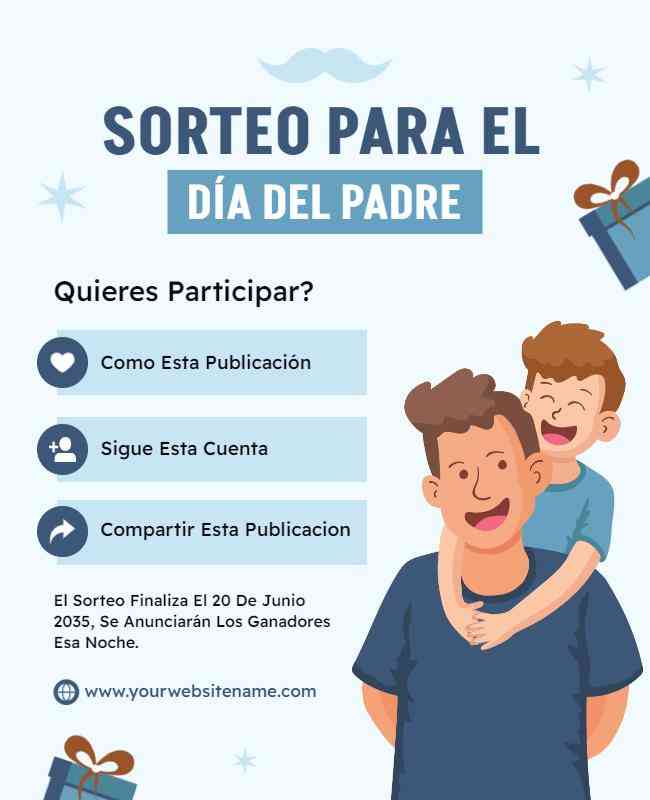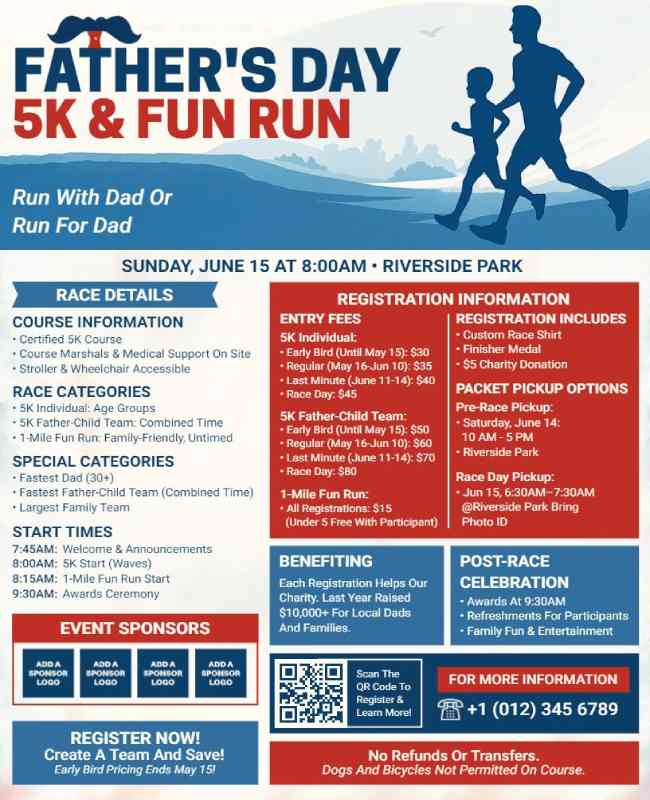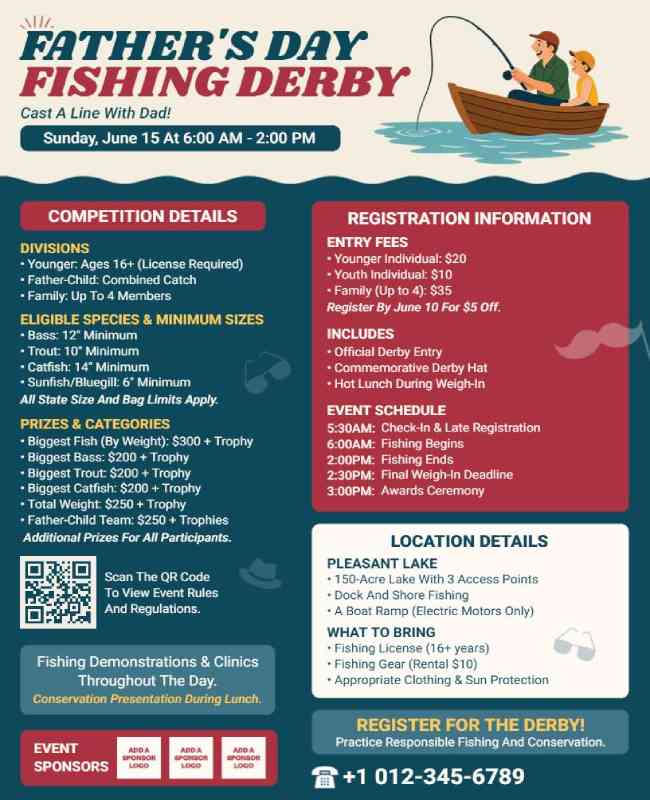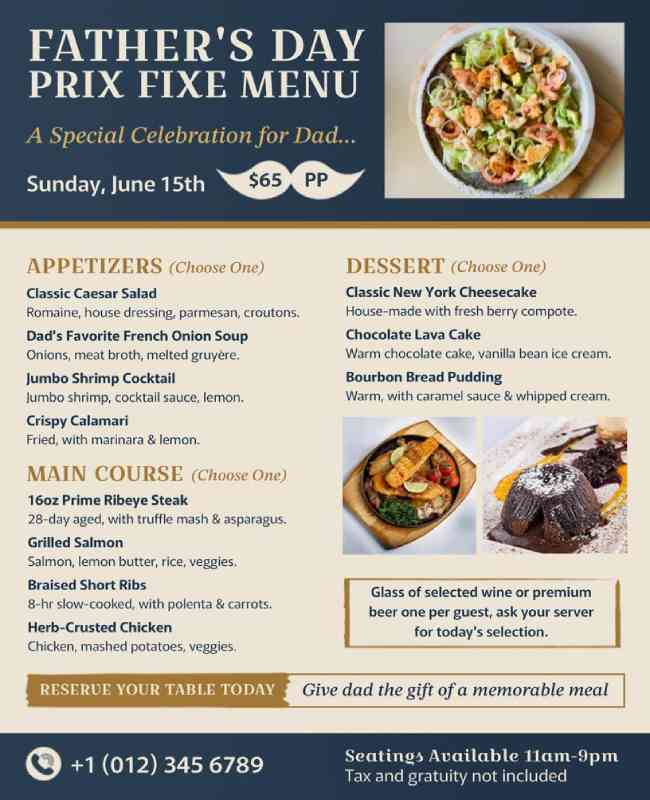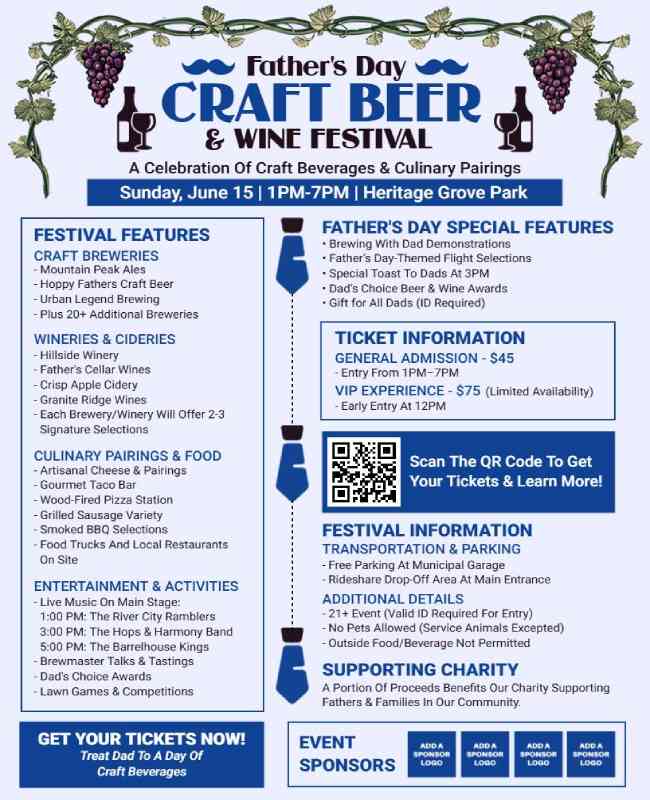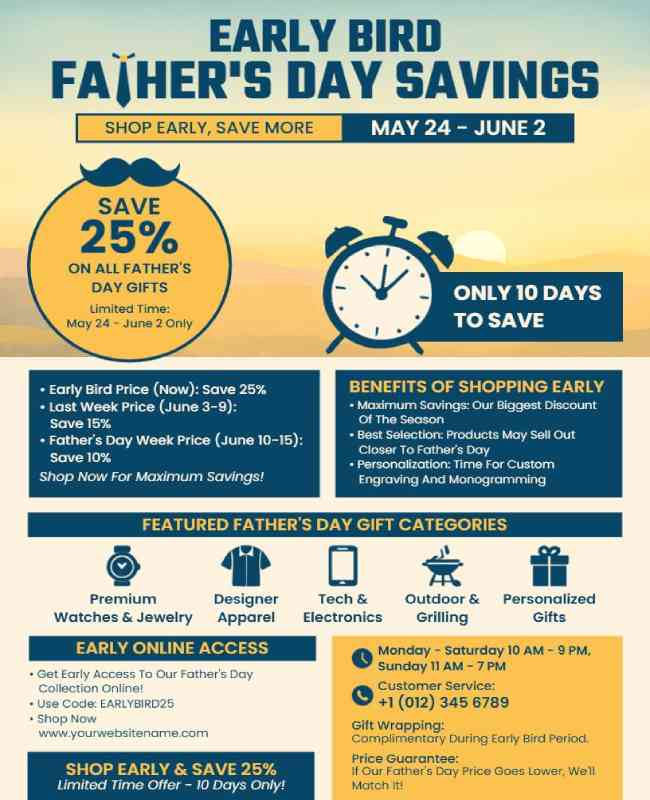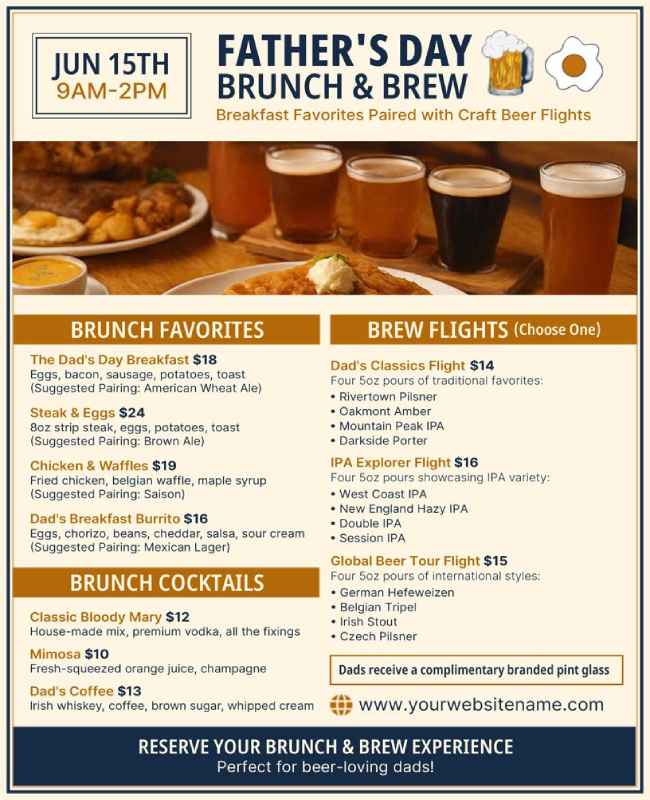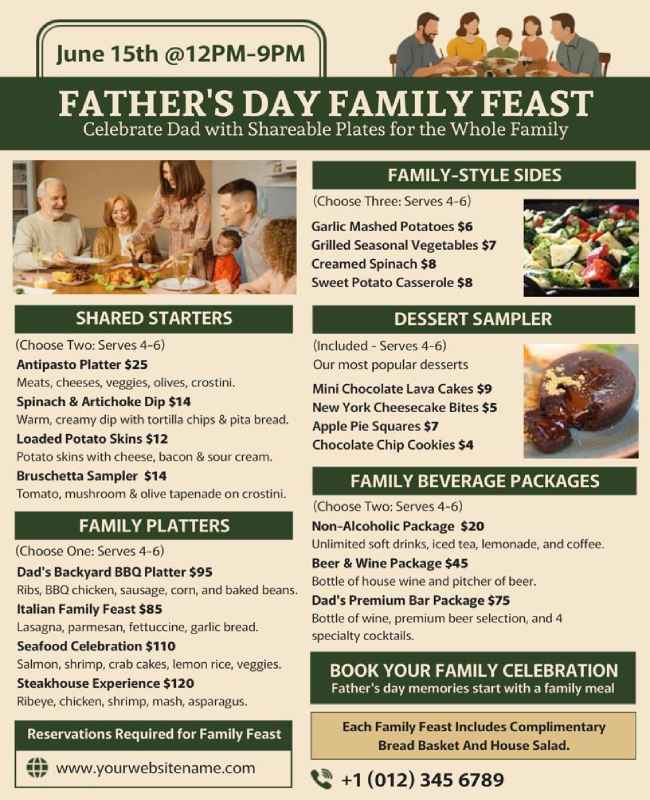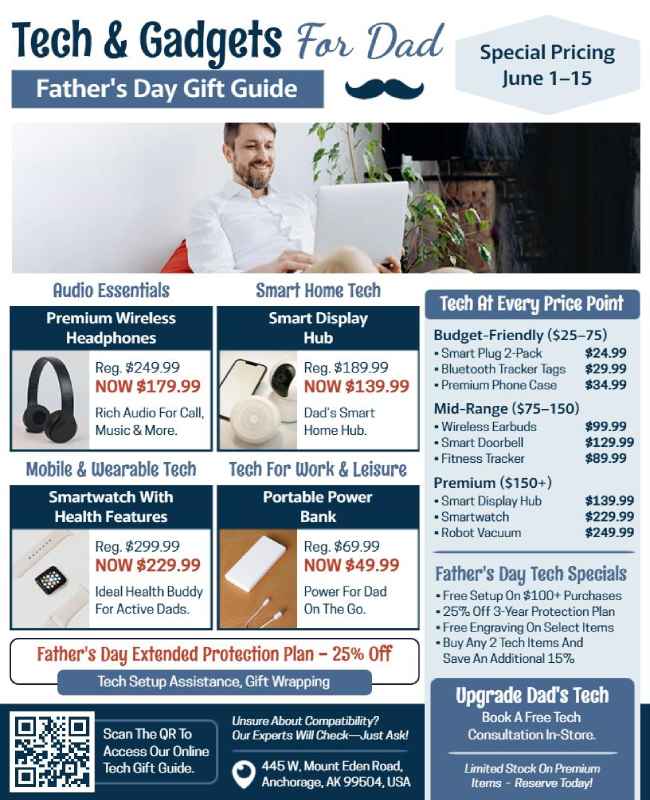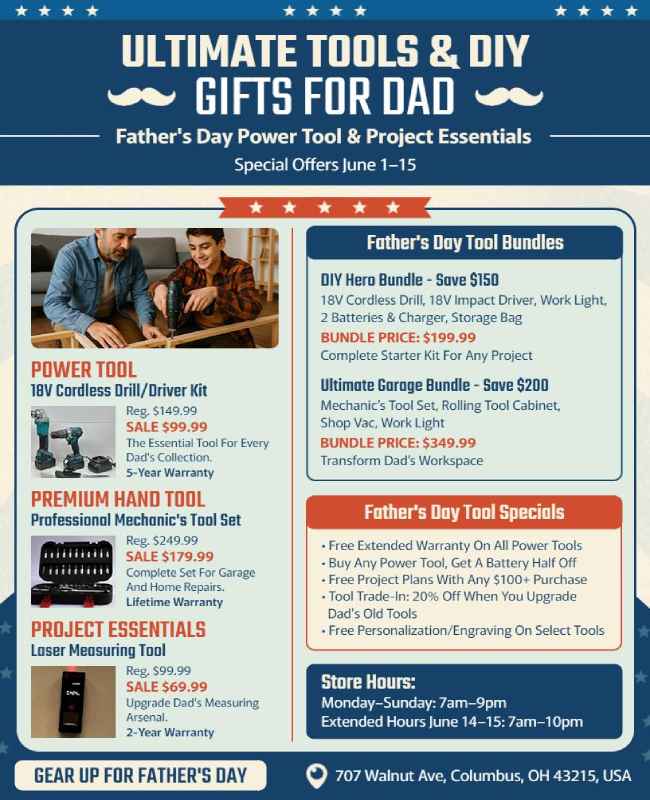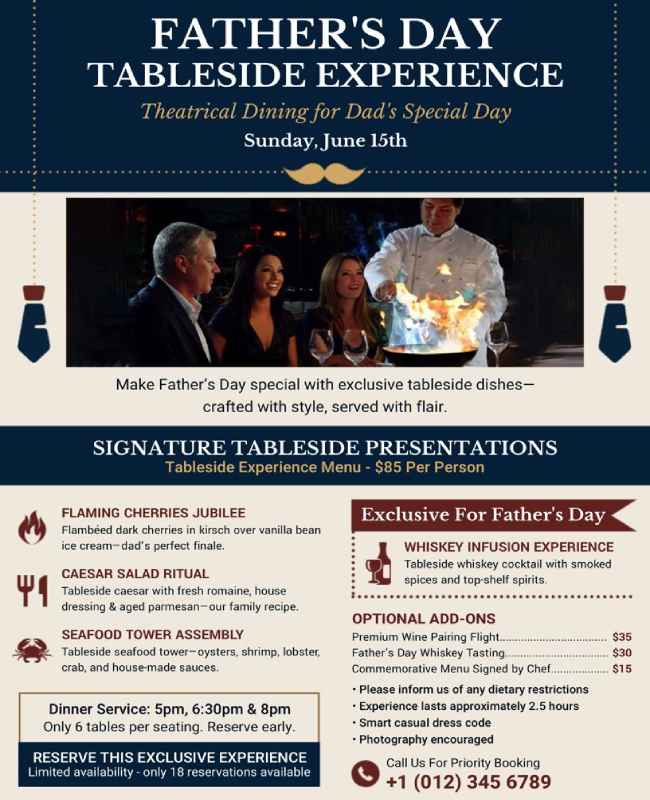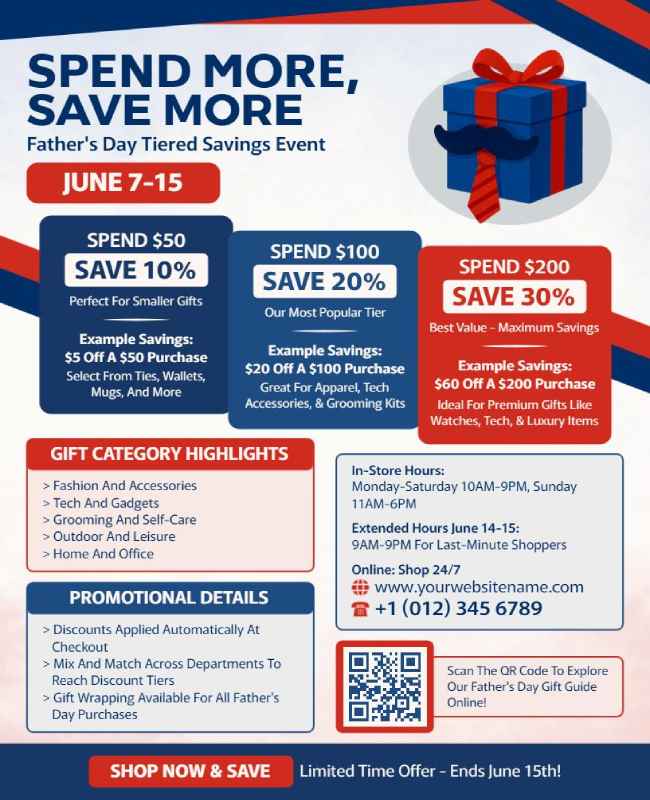Celebrate dads in style! Choose from ready-made flyer templates that are festive, professional, and easy to customize for any Father’s Day event or promotion.
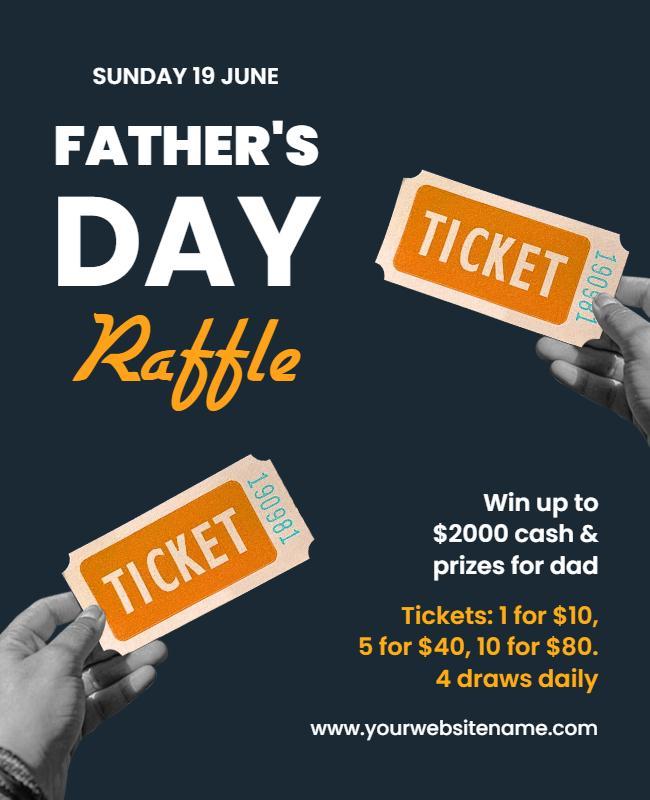

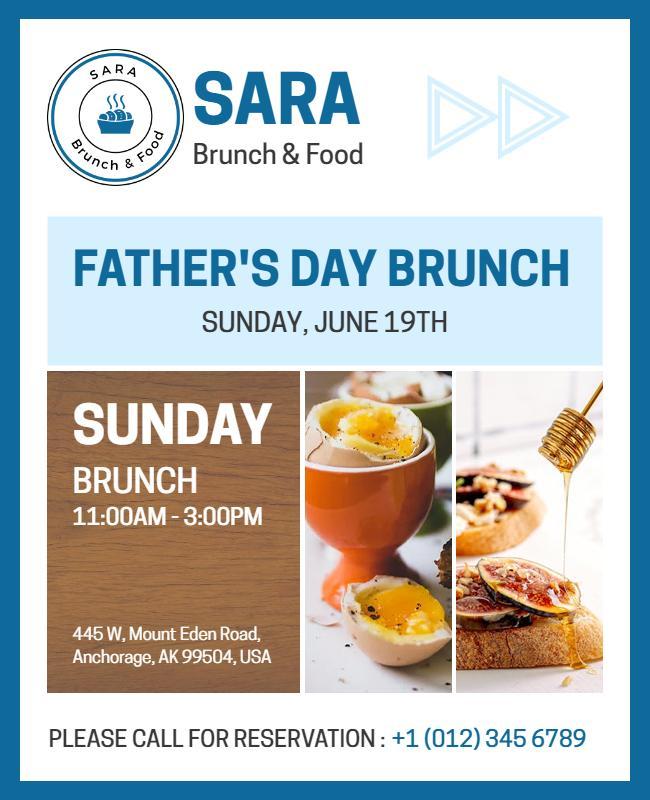

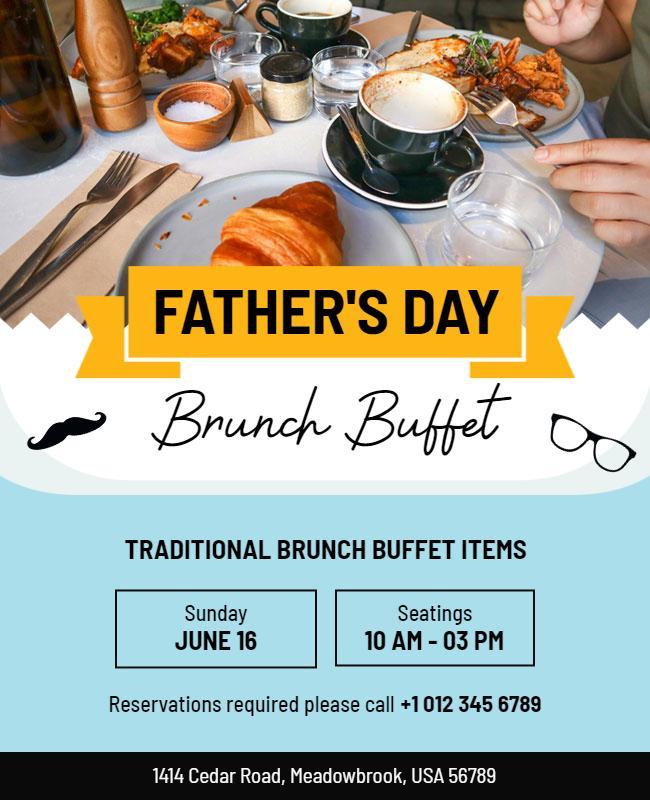

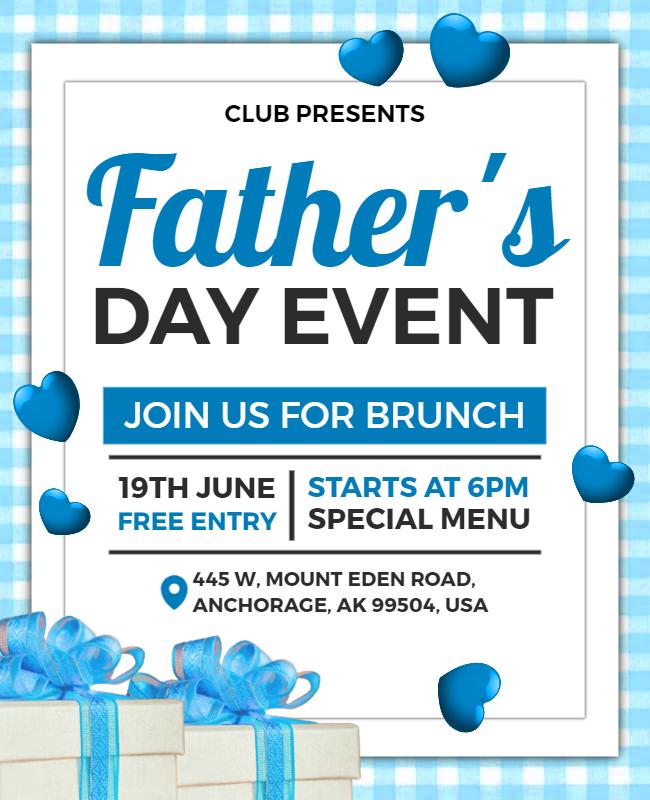
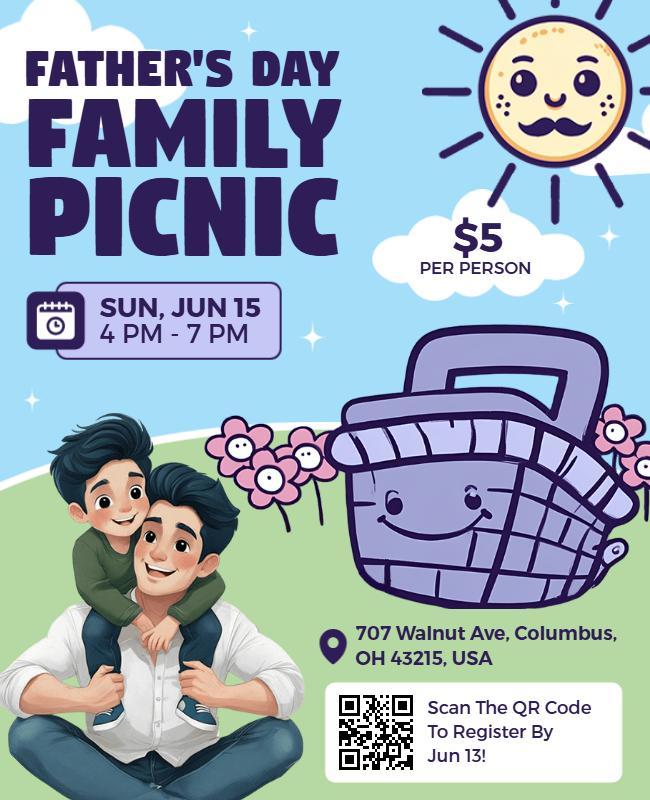
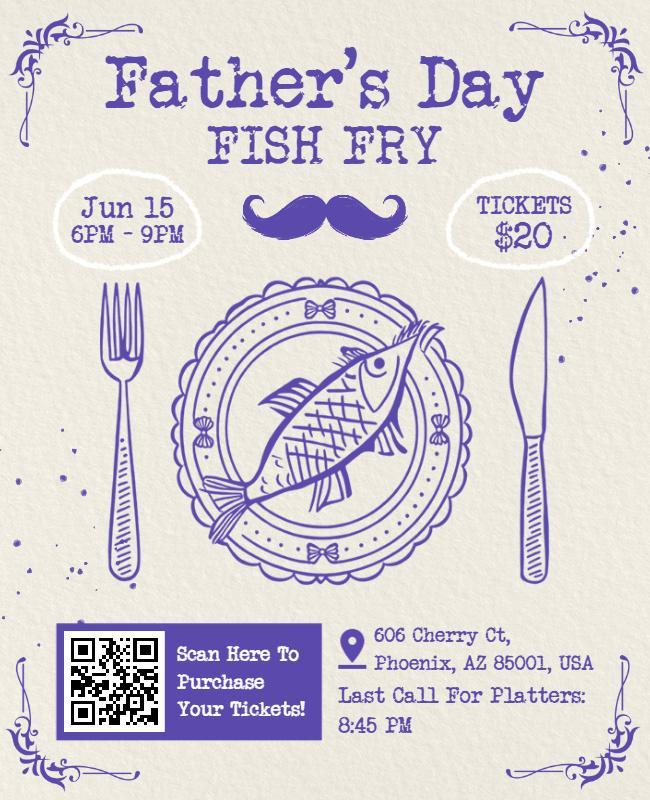
Father’s Day offers a great chance for businesses and organizations to connect with customers through eye-catching promotional posters. Whether you’re promoting a special menu, sale, event, or service, a well-designed poster can boost your visibility and engagement.
Creating professional Father’s Day posters doesn’t have to be hard or costly. With the right templates and design tips, you can quickly make stunning posters that get results. This guide covers everything you need to design, print, and display effective posters for Father’s Day 2025. Plus, access 15 ready-to-use templates to customize for your needs.
Best Father’s Day Poster Design Trends for 2025
Staying current with design trends ensures your Father’s Day posters feel fresh and relevant. For 2025, several key trends are defining the most effective Happy Father’s Day poster designs.
Color Trends Dominating 2025
This year’s Father’s Day poster color palettes are moving beyond traditional blues to embrace more diverse and sophisticated combinations:
- Classic Blues with a Twist: Navy and royal blues remain popular but are being paired with unexpected accent colors like coral, mustard, or sage green for a contemporary feel
- Rich Earthy Tones: Terracotta, olive, and warm browns are gaining popularity for their natural, grounded aesthetic
- Metallic Accents: Gold, silver, and bronze details add a touch of elegance and celebration
- Monochromatic Schemes: Single-color designs using various shades and tints of one color (particularly blues and greens) create sophisticated, cohesive looks
The most effective posters use color psychology strategically, with cool tones creating trust and warm accents drawing attention to key information like dates and offers.
Typography Trends for Maximum Impact
Typography choices for 2025 Fathers Day posters are emphasizing:
- Bold, Chunky Serifs: Statement headline fonts with substantial weight
- Clean Sans-Serif Pairings: For body text and supporting information
- Handwritten Accents: Personal touches for emotional connection
- Vertical Text Arrangements: Creating visual interest and modern appeal
- Variable Width Layouts: Mixing condensed and expanded fonts for dynamic contrast
Remember that poster typography must be legible from a distance. Even trending decorative fonts should be limited to short headlines or accent phrases.
Visual Style Trends
Beyond color and typography, these visual approaches are trending for Father’s Day 2025:
- Authentic Imagery: Real, diverse representations of fatherhood rather than stock-photo stereotypes reflected in many modern Father’s Day Flyer Template designs.
- Minimalist Designs: Clean layouts with strategic white space and focused messaging
- Geometric Elements: Abstract shapes and patterns adding visual interest
- Subtle Textures: Adding depth without overwhelming the design
- Gradient Backgrounds: Creating dimension and visual interest
What sets 2025’s trends apart is the move toward more authentic, emotionally resonant visuals that avoid dated Father’s Day clichés.
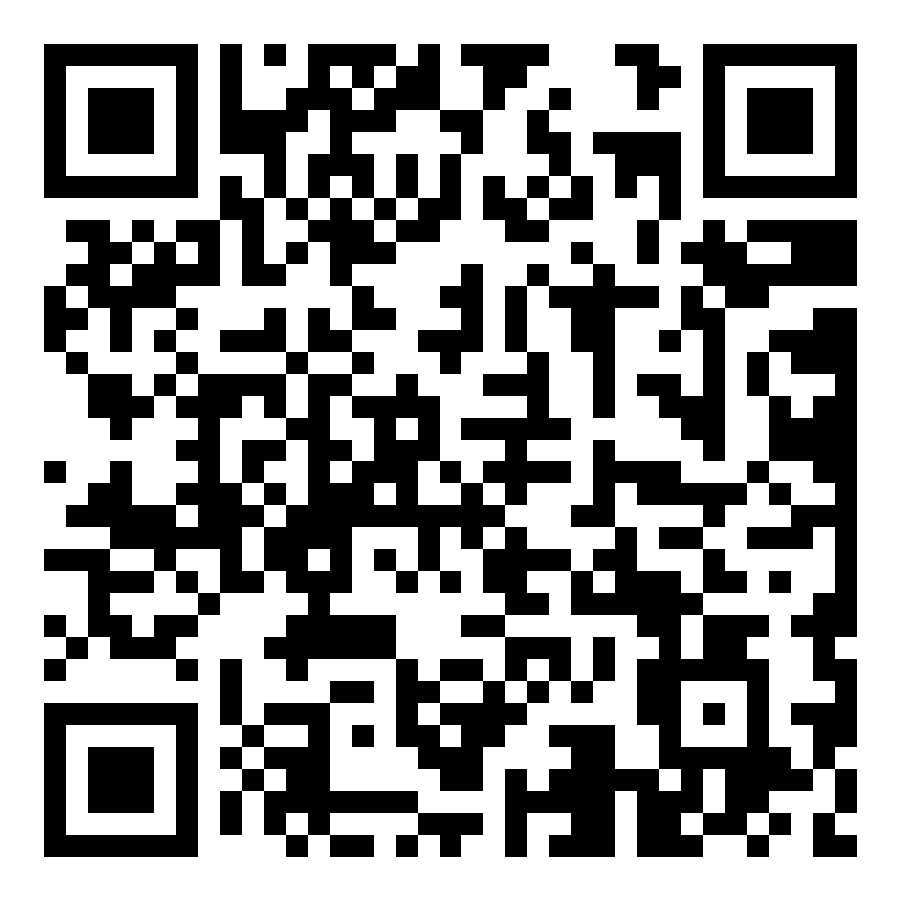
Father’s Day Poster Size Guide & Specifications
Choosing the right poster size is crucial for your specific application and viewing environment. Understanding standard dimensions and technical specifications ensures professional results.
Standard Poster Sizes and Applications
Each poster size serves different purposes and viewing scenarios:
| Size (inches) | Size (metric) | Best Use Cases |
|---|---|---|
| 11″ x 17″ | A3 (297 x 420mm) | Indoor displays, counter displays, smaller businesses |
| 18″ x 24″ | A2 (420 x 594mm) | Store windows, community boards, medium viewing distance |
| 24″ x 36″ | A1 (594 x 841mm) | Large indoor displays, event promotion, trade shows |
| 27″ x 40″ | – | Movie-style posters, premium promotions, larger venues |
| 36″ x 48″ | A0 (841 x 1189mm) | Major promotions, significant viewing distance |
Digital poster formats should maintain these aspect ratios while adapting to platform-specific requirements.
According to the Texas A&M University College of Pharmacy, standard academic poster sizes include 36″ x 48″ (landscape) and 42″ x 56″ (portrait), commonly used for research presentations and conferences.1
How To Choose The Right Size?
Consider these factors when selecting your Dad posters size:
- Viewing Distance: Larger sizes for greater distances; smaller sizes for close-up viewing
- Display Location: Available space in your intended display areas
- Content Volume: How much information needs to be included
- Budget Considerations: Larger posters cost more to print and display
- Distribution Plans: Whether you’ll be mailing posters or displaying them yourself
For most small-to-medium businesses, 18″ x 24″ provides the optimal balance of visibility and affordability for Father’s Day promotions.
Technical Specifications for Professional Results
Ensure your Father’s Day poster meets these technical requirements:
- Resolution: 300 DPI (dots per inch) minimum for print quality
- Color Mode: CMYK for printed posters; RGB for digital-only displays
- Bleed Area: Add 0.125″ (3mm) beyond the trim edge for borderless designs
- Safe Zone: Keep important content at least 0.25″ (6mm) from edges
- File Format: PDF (preferred), JPEG, or TIFF for printing; PNG or JPEG for digital
When scaling content between poster sizes, maintain proportional relationships rather than simply stretching elements.
Creative Father’s Day Poster Ideas for 2025
Need inspiration for your Dad poster? Here are ten creative approaches that can be adapted for any industry or purpose.
Minimalist Typography Focused Design
Concept: Let powerful words do the heavy lifting with minimal visual elements.
Key Elements
- Bold, impactful typography as the main visual element
- Limited color palette (2-3 colors maximum)
- Strategic use of white space
- Single powerful message or phrase about fatherhood
Best For: Upscale restaurants, premium retailers, sophisticated service businesses
Pro Tip: For typography-focused designs, invest time in finding the perfect font pairing that creates visual contrast while maintaining harmony.
Father Child Photography Showcase
Concept: Capture the emotional connection between fathers and children.
Key Elements
- High-quality, authentic photography as the central focus
- Minimal text overlays that don’t obscure the imagery
- Color treatment that enhances emotional impact
- Diversity in representation of father figures
Best For: Family-oriented events, community celebrations, retail stores selling gifts
Pro Tip: Avoid generic stock photos; authentic, diverse imagery creates stronger emotional connections with viewers.
Vintage/Retro Father’s Day Theme
Concept: Evoke nostalgia with design elements from previous decades.
Key Elements
- Period-appropriate typography styles
- Retro color palettes (think 50s pastels, 70s earth tones, 80s neons)
- Vintage textures and graphic elements
- Historical references that resonate with your audience
Best For: Established businesses, community traditions, multi-generational appeals
Pro Tip: Research authentic design elements from your chosen era rather than using generic “vintage” filters.
Interactive Father’s Day Poster
Concept: Engage viewers with elements that invite participation.
Key Elements
- QR codes linking to special offers or content
- Tear-off elements with coupons or information
- Augmented reality features accessible via smartphone
- Fill-in sections for personalization
Best For: Tech-forward businesses, locations with lingering foot traffic, multi-channel campaigns
Pro Tip: Always include clear instructions for how to interact with the poster’s special features.
Event Specific Father’s Day Posters
Concept: Focus on a specific Father’s Day event or activity.
Key Elements
- Clear date, time, and location information
- Visuals that represent the specific activity (sports, dining, workshop)
- Pricing and registration information
- Benefits of participation clearly stated
Best For: Restaurants hosting Father’s Day brunches, community centers, sports facilities, entertainment venues
Pro Tip: Use action-oriented imagery that helps viewers envision themselves participating in the event.
Industry Specific Conceptual Posters
Concept: Tailor your poster concept specifically to your industry.
Key Elements
- Visual metaphors relevant to your business type
- Industry-specific terminology and references
- Solutions to industry-specific Father’s Day challenges
- Professional imagery related to your field
Best For: Specialized businesses, B2B companies, professional services
Pro Tip: Find the intersection between Father’s Day themes and your specific industry value proposition.
Modern Abstract Father’s Day Design
Concept: Use contemporary design elements for a cutting-edge feel.
Key Elements
- Abstract shapes and patterns
- Bold, unexpected color combinations
- Asymmetrical layouts
- Minimal copy with maximum impact
Best For: Fashion retailers, modern restaurants, tech companies, brands with younger demographics
Pro Tip: Even abstract designs should maintain a clear hierarchy that guides the viewer’s eye to key information.
Father’s Day Poster Design Essential Elements
No matter which creative direction you choose, every effective Father’s Day poster must include these essential elements and follow these design principles.
Must Have Content Elements
Ensure your poster includes these critical components:
- Clear Headline: Immediately identifies it as a Father’s Day promotion
- Key Benefit or Offer: What makes your Father’s Day offering special
- Essential Details: Date, time, location, pricing as applicable
- Business Identification: Your brand name and logo
- Call-to-Action: What you want viewers to do next
- Contact Information: How to reach you or find more details
For posters, this information must be strategically prioritized since viewers typically spend only 2-3 seconds scanning the content.
Layout Principles for Maximum Impact
Follow these layout guidelines to ensure your poster commands attention:
- Visual Hierarchy: Guide the viewer’s eye in a deliberate sequence using size, color, and placement
- Rule of Thirds: Place key elements at intersection points for a balanced composition
- Strategic White Space: Allow breathing room around important elements
- Z-Pattern Design: Arrange elements to follow natural eye movement (top-left to bottom-right)
- Focal Point Creation: Establish a clear visual center that draws initial attention
Remember that posters are viewed differently than flyers or digital content, so the customizable flyer templates should ensure all elements are visible and impactful from greater distances.
Typography Best Practices for Posters
Follow these guidelines for effective poster typography:
Size Requirements:
- Headlines: Minimum 72pt for standard posters
- Subheadings: Minimum 48pt
- Body Copy: Minimum 24pt
- Fine Print: Minimum 14pt (but still legible at reading distance)
Readability Principles:
- Maintain high contrast between text and background
- Limit to 2-3 font families maximum
- Use font weights to create hierarchy
- Ensure adequate spacing between text elements
Viewing Distance Formula:
- For every 10 feet of viewing distance, text should be at least 1 inch tall for essential information.
Design Elements for Maximum Impact
Enhance your poster’s effectiveness with these design considerations:
Color Psychology
- Use high contrast for readability (70% difference between text and background)
- Apply color strategically to highlight key information
- Consider environmental lighting when selecting colors
Border and Frame Usage
- Add borders for posters displayed among competing materials
- Use frames to create perception of higher value
- Consider edge treatment for borderless designs
Visual Anchors
- Include one dominant image rather than many small ones
- Use visual elements to direct attention to key information
- Create visual breaks between content sections
How To Design a Father’s Day Poster That Converts
Follow this proven step-by-step process to create Fathers Day posters that not only look great but actually drive results.
Step 1: Set Clear Objectives
Before designing, define exactly what you want your poster to accomplish:
Define Success Metrics
- Foot traffic increase percentage
- Event attendance numbers
- Special offer redemptions
- Website visits using a dedicated URL
Identify Target Audience
- Primary: Who will be viewing the poster?
- Secondary: Who makes decisions about Father’s Day activities?
- Consider demographics, preferences, and behaviors
Establish Key Message
- What is the ONE thing viewers should remember?
- How does this connect to fathers specifically?
- What differentiates your offering from competitors
Determine Call-to-Action
- What specific action should viewers take?
- How will you motivate this action?
- How will you track response?
Step 2: Plan Your Design Approach
With objectives clear, plan your design execution:
Content Gathering
- Collect all required information (dates, prices, details)
- Obtain high-resolution logo files
- Source or create appropriate imagery
- Get all necessary approvals on offers and language
Design Direction Selection
- Choose from the 10 creative approaches outlined earlier
- Select appropriate templates that match your approach
- Define color palette and typography choices
- Sketch basic layout options
Template Selection
- Browse our free Father’s Day poster templates
- Select a design that aligns with your objectives and brand
- Consider customization requirements
Step 3: Create Your Poster
Now it’s time to bring your plan to life:
Template Customization
- Replace placeholder text with your content
- Update images with your selected visuals
- Adjust colors to match your brand guidelines
- Modify layout elements as needed
Visual Hierarchy Implementation
- Ensure your headline stands out first
- Create clear path for the eye to follow
- Highlight offer and call-to-action
- De emphasize secondary information
Design Refinement
- Adjust text size for readability
- Ensure color contrast meets accessibility standards
- Check spacing between elements
- Verify all information is accurate and complete
Step 4: Test Your Design
Before finalizing, validate your poster’s effectiveness:
Distance Testing
- View poster from appropriate distances
- Verify key information is readable
- Check if the visual hierarchy works from afar
Message Clarity Verification
- Ask others what they notice first
- Confirm they understand the offer
- Verify they know what action to take
Conversion Element Check
- Ensure call-to-action stands out
- Verify contact information is clear
- Confirm dates/times are prominent
Step 5: Prepare for Production
Finalize your design for output:
Technical Specification Verification
- Confirm correct dimensions and resolution
- Check color mode (CMYK for print, RGB for digital)
- Verify bleed and margin settings
File Preparation
- Create print-ready PDF with proper settings
- Generate appropriate file formats for digital display
- Organize files with clear naming conventions
Quality Assurance
- Proofread all text
- Double-check dates and pricing
- Review design at actual output size
- Get final approval from all stakeholders
Learn more with our detailed Father’s Day Flyer Design Guide.
Designing the perfect Happy Father’s Day poster just got easier. Use this layout builder to customize everything from headlines and images to CTAs and decorative elements, all in a few guided steps.
Father’s Day Poster Printing & Display Guide
Creating the perfect design is just the beginning—proper printing and strategic display are equally important for poster success.
Printing Options Comparison
Choose the right printing approach based on your needs and budget:
| Printing Method | Best For | Typical Cost | Lead Time | Quality Level |
|---|---|---|---|---|
| Digital Printing | Small runs (1-50), quick turnaround | $5-15 per poster | 1-3 days | Good |
| Offset Printing | Larger runs (50+), premium quality | $3-10 per poster | 5-7 days | Excellent |
| Large Format Inkjet | Extra-large sizes, indoor display | $15-40 per poster | 1-5 days | Very Good |
| Screen Printing | Special effects, vibrant colors | $8-25 per poster | 7-10 days | Excellent for limited colors |
| Print-on-Demand Services | Convenience, small quantities | $10-20 per poster | 3-7 days | Variable |
| In-House Printing | Immediate needs, basic designs | Cost of materials | Immediate | Variable |
Paper Stock and Finish Selection
Your paper choice significantly impacts your poster’s appearance and durability:
- Text Weight (20-28 lb): Economical but not durable for posters
- Cover Stock (80-100 lb): Standard for indoor posters
- Card Stock (120-140 lb): Premium feel, good durability
- Synthetic Papers: Waterproof option for outdoor display
Popular finish options include
- Gloss: Vibrant colors, less readable under direct light
- Matte: Reduced glare, sophisticated appearance
- Satin/Silk: Balance between gloss and matte
- Specialty Finishes: Spot UV, foil stamping, embossing for premium impact
Strategic Poster Placement
Maximize visibility with these placement strategies:
Location Analysis
- Identify high-traffic areas relevant to your target audience
- Consider viewing distance and angle at each location
- Evaluate lighting conditions throughout the day
- Assess competition from other visual elements
Mounting Considerations
- Window mounting: Consider double-sided printing for inside/outside viewing
- Wall mounting: Use appropriate hardware for surface type
- Freestanding displays: Ensure stability and proper height
- Hanging displays: Account for movement and viewing angles
Grouping Strategies
- Create impact with multiple coordinated posters
- Consider sequence placement along common walking paths
- Use consistent branding across multiple locations
- Create themed poster “zones” for enhanced attention
Environmental Factors
- Protect from direct sunlight to prevent fading
- Consider weather exposure for outdoor placements
- Account for air vents, doors, and other environmental elements
- Evaluate evening visibility needs (illumination)
Digital Display Adaptation
If showing your poster on digital screens:
Format Adjustments
- Convert to appropriate aspect ratios (16:9, 9:16, 4:3)
- Optimize file size for loading performance
- Create motion-enhanced versions where appropriate
- Develop interactive elements for touchscreen displays
Platform-Specific Considerations
- Social media: Adapt design for platform-specific dimensions
- Digital signage: Account for transition timing and viewing distance
- Website display: Ensure responsive scaling for different devices
- Email marketing: Optimize for preview panes and mobile devices
15 Free Father’s Day Poster Templates
Jump-start your Father’s Day promotion with our collection of free, professionally designed poster templates. Each template is fully customizable to match your specific needs and brand identity.
Restaurant & Food Service Templates
Perfect for promoting Father’s Day specials, brunches, dinners, and culinary events:
Learn more about Father’s Day Restaurant Flyer Design Guide.
Retail & Shopping Templates
Ideal for promoting Father’s Day sales, gift ideas, and special offers:
Learn more about Father’s Day Retail Sale Flyer Design Ideas.
Event & Activity Templates
Designed for Father’s Day events, activities, and community celebrations:
Learn More About Father’s Day Event Flyer Tips.
Service Business Templates
Tailored for service-based businesses offering Father’s Day specials:
Learn More About Father’s Day Service Business Guide.
Multi Purpose Templates
Versatile designs that can be adapted for various industries:
Each template includes
- Professionally designed layout
- Customizable text, colors, and images
- Print-ready settings with proper bleed and margins
- Digital-friendly versions for online sharing
- Easy editing via the DesignWiz platform
FAQs About Father’s Day Posters
Father’s Day flyers are typically smaller (8.5″ x 11″ or smaller), contain more detailed information, and are designed for closer reading often distributed directly to potential customers. Posters are larger (11″ x 17″ and up), designed to be read from a distance, contain less text, and focus on visual impact to draw attention. Posters generally emphasize key messages and visuals, while flyers can include more comprehensive information about Father’s Day offerings.
Begin designing your Father’s Day poster 6-8 weeks before Father’s Day (early-to-mid April) to allow time for design revisions and printing. Plan to have posters printed and ready for distribution 3-4 weeks before Father’s Day (late May) when consumer planning typically begins. For larger campaigns or premium printing options that require longer lead times, start the design process even earlier. Digital poster versions should follow the same timeline to maintain campaign consistency.
Choose poster sizes based on viewing distance and location: use 11″ x 17″ for close-viewing environments like restaurant entrances or retail checkout areas; 18″ x 24″ for standard storefronts and community boards; 24″ x 36″ for larger spaces with viewing distances of 10+ feet; and 27″ x 40″ or larger for significant events or venues where viewing may occur from 20+ feet away. Always consider the surrounding visual competition larger posters may be necessary in busy environments with many competing visuals.
Professional Father’s Day poster printing typically costs $5-15 per poster for standard sizes (18″ x 24″) with quantities of 10-50. Larger sizes (24″ x 36″) range from $15-30 per poster. Costs vary based on: quantity (higher quantities reduce per-unit cost), paper quality (standard vs. premium stocks), size (larger posters cost more), finish options (specialty finishes add cost), and turnaround time (rush printing increases prices). Digital printing is usually more economical for small runs, while offset printing becomes cost-effective for quantities over 100.
Absolutely! Non-designers can create professional-looking Father’s Day posters using pre-designed templates like those offered by DesignWiz. Templates provide professionally structured layouts where you can simply replace text and images. For best results: start with a template that closely matches your needs; use high-quality images (even smartphone photos with good lighting); keep text minimal and well-organized; follow the template’s built-in font pairings; and use complementary colors from your brand palette. Many template platforms offer simple editing tools specifically designed for non-designers.
The most effective Father’s Day poster calls-to-action are specific, action-oriented, and create urgency. Instead of a generic “Call Today,” a restaurant might use “Reserve Dad’s Table Now” to encourage immediate booking. In retail, a CTA like “Shop Our Father’s Day Sale June 12–16” clearly outlines both the action and timeframe. Event promotions benefit from urgency-driven phrases such as “Register by June 10 for Early Bird Pricing.” The best CTAs use active verbs (Reserve, Shop, Register, Call, Visit), highlight benefits (“Save 25% When You Book Online”), and provide clear next steps with simplified contact information.
Measure your Father’s Day poster’s effectiveness by implementing trackable elements: use unique QR codes linking to campaign-specific landing pages; create poster-specific discount codes; include tear-off elements that must be presented; establish dedicated phone extensions for poster responses; use dedicated landing page URLs (e.g., yourbusiness.com/fathersday2025); or simply ask customers “How did you hear about our Father’s Day special?” during interactions. Compare results against previous years or similar promotions, tracking metrics like response rate, conversion rate, and overall campaign ROI.
Common Father’s Day poster design mistakes include: overcrowding with too much information (stick to essential details); using fonts that are too small for viewing distance; poor color contrast that reduces readability; relying on clichéd, stereotypical imagery (ties, tools, grills); unclear call-to-action placement; poor quality printing that undermines professional image; bland or generic messaging that fails to differentiate your offering; and neglecting to include key information like dates or contact details. Also avoid last-minute distribution that doesn’t allow sufficient planning time for potential customers.
Need Help With Your Father’s Day Poster?
Our support team is available to assist with template selection, customization questions, and printing advice. Visit our help center for additional resources.
Don’t wait until the last minute Father’s Day planning starts now! Create your professional poster today and ensure your Father’s Day promotion stands out from the competition.
Reference
- “Poster Printing Guidelines.” Retrieved May 29, 2025. Texas A&M University College of Pharmacy.










